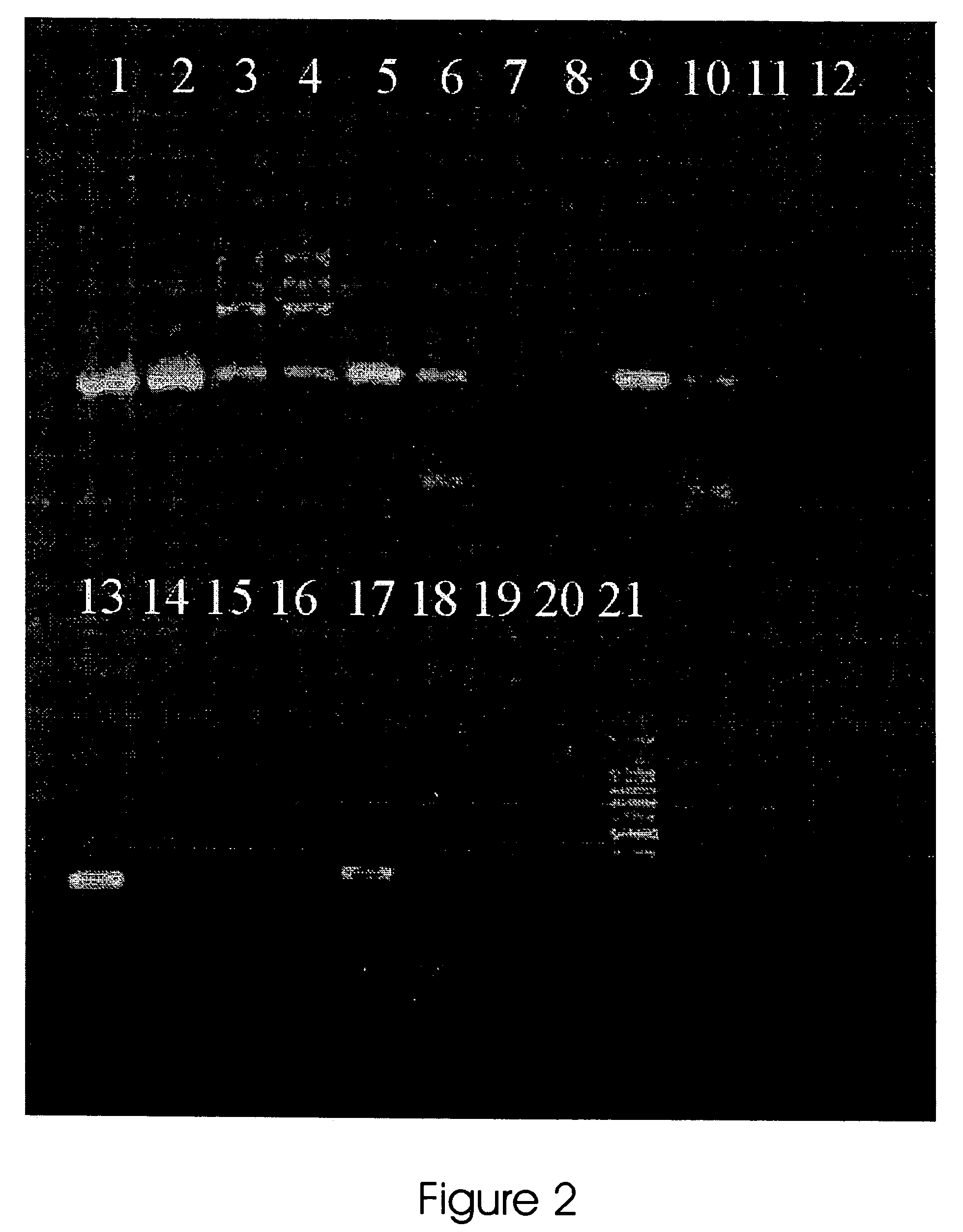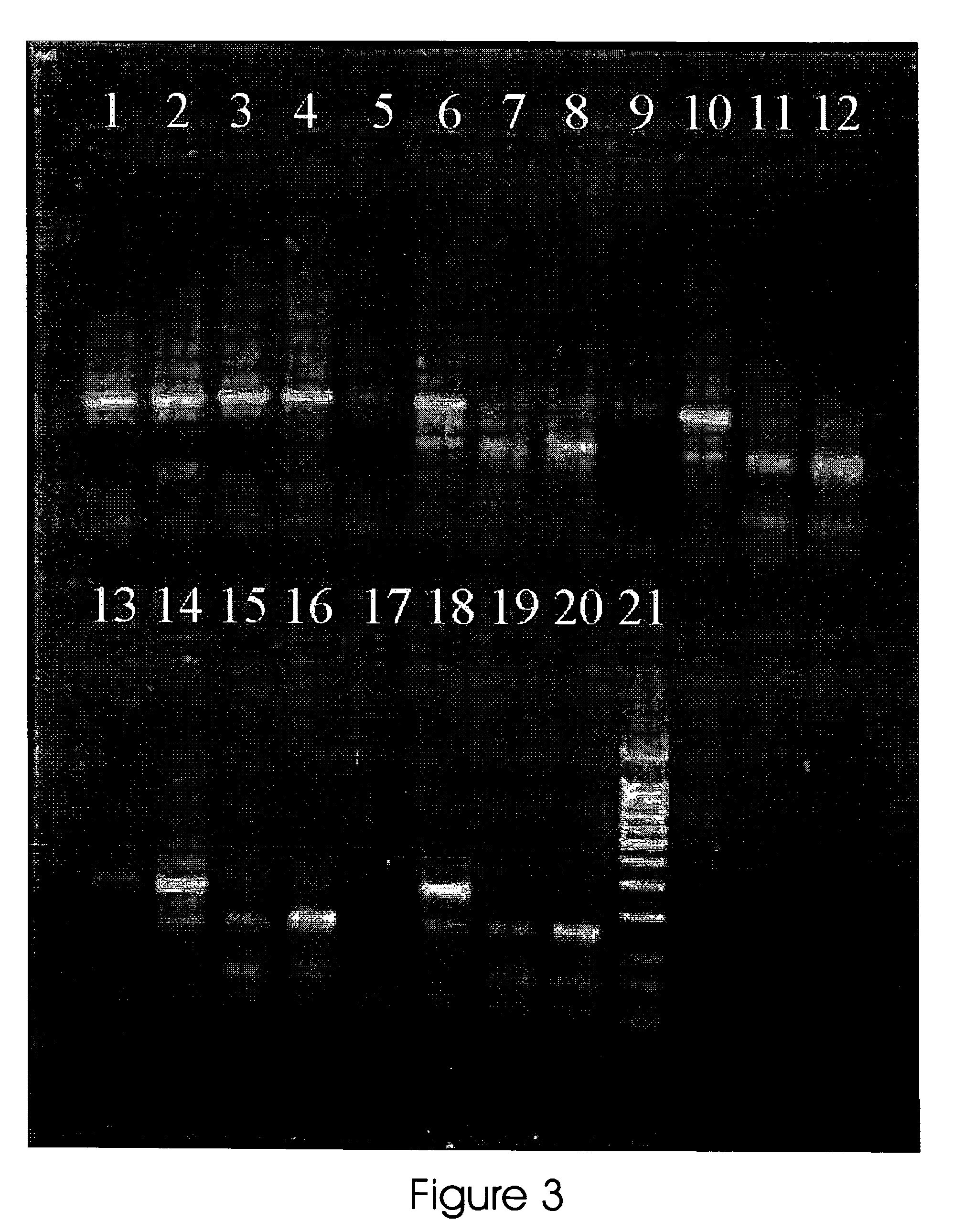Methods and reaction mixture reagent for increasing the specificity and fidelity of polymerase reactions
a polymerase and reaction mixture technology, applied in the field of molecular biology, can solve the problems of limited informative power of gene variation analysis and gene mutation analysis, limited general application of the technique in a simple and universal fashion, false findings, etc., to increase the selectivity detection of single nucleotide mutations, suppress false positive extension products, and reduce the amount of extension products
- Summary
- Abstract
- Description
- Claims
- Application Information
AI Technical Summary
Benefits of technology
Problems solved by technology
Method used
Image
Examples
example 1
DNA Purification and PCR Amplification
[0078]Total DNA was purified from fresh human blood by a salting out procedure using the Wizard® Genomic DNA Purification kit (Promega). Blood was collected in 1.5 ml microtubes containing 100 μl 0.5M EDTA as anticoagulant. Total yield of DNA was about to 10 μg for each sample.
[0079]PCR amplifications were performed in a MJ Research PTC-150 thermal cycler in a 25 μl reaction volume containing 10 mM Tris-HCl (pH 9.0), 50 mM KCl, 0.1% Triton® X-100, 1.5 mM MgCl2, 200 uM each deoxy-NTP, 1.5 U Taq DNA Polymerase (Promega Corp.), 25 pmol of upstream primer, 10 pmol of downstream primer and 10 ng of total DNA. Cycling conditions included an initial denaturalization step of 2 min. at 95° C., followed by 36 cycles of 30 sec. at 95° C., 30 sec. at 53° C. and 1 min at 72° C. PCR products were electrophoresed through a 26 agarose gel and visualized with ethidium bromide.
example 2
Addition of EtBr to the PCR Reaction Mixture to Improve the Specificity of DNA Amplification
[0080]A 299 bp region of the human mitochondrial D-loop (16,031-16,330) carrying cytosine nucleotide (C) at position 16311 was amplified in four separate PCR reactions sharing the same upstream primer (FWD I Upstream primer 5′-ATG GGG AAG CAG ATT TGG GT-3′ (SEQ ID NO:1) and having either of the four 3′-end alternative downstream primers (16311A (SEQ ID NO:3) downstream primer 5′-ACG GTA AAT GGC TTT ATG TA-3′, 16311G (SEQ ID NO:4) downstream primer 5′-ACG GTA AAT GGC TTT ATG TG-3′, 16311T (SEQ ID NO:5) downstream primer 5′-ACG GTA AAT GGC TTT ATG TT-3′, 16311C (SEQ ID NO:6) downstream primer 5′-ACG GTA AAT GGC TTT ATG TC-3′). The PCR was carried out as in the example 1, except of increasing concentrations of ethidium bromide were added to assess the effect on the amplification of the primers carrying different 3′ nucleotides. The increasing concentrations of ethidium bromide were from 4.5 to 6...
example 3
The Effect of Primer Concentration and Amount of Template in the Methods of the Invention
[0083]To assess if the primer concentration can affect the selectivity brought about by the addition of ethidium bromide, was tested different amounts of the otherwise hard to distinguish primers 16311A (SEQ ID NO:3) and 16311G (SEQ ID NO:4) (sequence showed above) in mtDNA carrying cytosine nucleotide (C) at position 16311. The PCR was carried out as in the example 1. Ethidium bromide concentration in the PCR reaction mixture was 5.0 μg / ml and primers amounts were from 0.5 to 100 pmole.
[0084]To verify if ethidium bromide was equally effective with different amounts of template, were added different amounts of mtDNA carrying cytosine nucleotide (C) at position 16311 to the reaction containing either primer 16311A (SEQ ID NO:3) or 16311G (SEQ ID NO:4).
[0085]The PCR was carried out as in the example 1. Ethidium bromide concentration in the PCR reaction mixture was 5.0 μg / ml, template amount was fr...
PUM
| Property | Measurement | Unit |
|---|---|---|
| molecular weight | aaaaa | aaaaa |
| concentration | aaaaa | aaaaa |
| concentrations | aaaaa | aaaaa |
Abstract
Description
Claims
Application Information
 Login to View More
Login to View More - R&D
- Intellectual Property
- Life Sciences
- Materials
- Tech Scout
- Unparalleled Data Quality
- Higher Quality Content
- 60% Fewer Hallucinations
Browse by: Latest US Patents, China's latest patents, Technical Efficacy Thesaurus, Application Domain, Technology Topic, Popular Technical Reports.
© 2025 PatSnap. All rights reserved.Legal|Privacy policy|Modern Slavery Act Transparency Statement|Sitemap|About US| Contact US: help@patsnap.com



